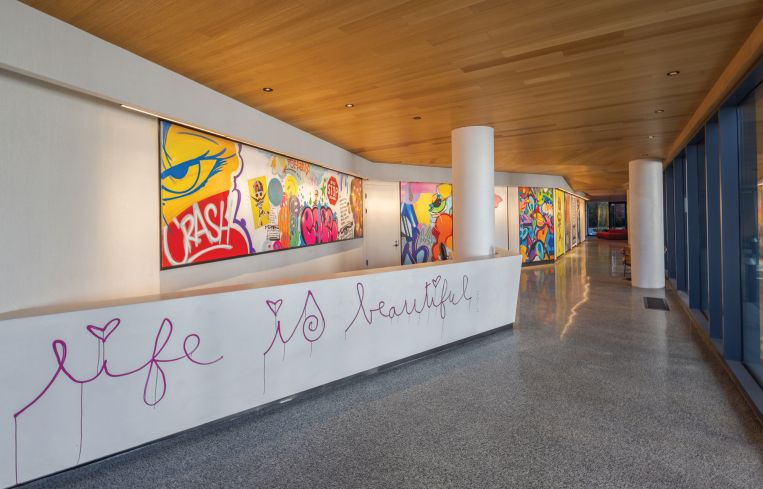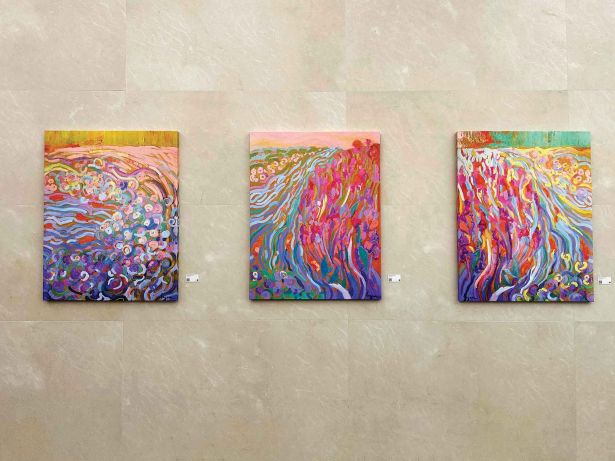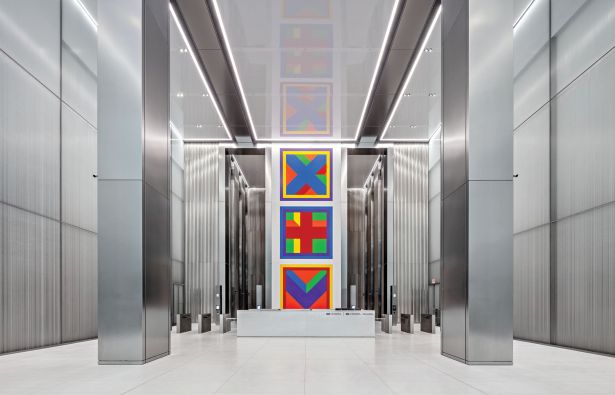Fine Art in NYC’s Post-COVID Commercial Real Estate: Everyone’s a Critic
That's because it's not just that these pieces pop or sell for a mint — there's a calculation to the curation
By Amanda Schiavo August 12, 2025 9:00 am
reprints
You see them in the capacious lobbies and the plush amenity spaces of New York’s newer office and residential spires. They are often striking and sometimes captivating. Works of art. Fine art at that, and often from names who can command five-, six- and even seven figures per piece.
The firms and forces behind these installations do it for the aesthetics, sure. But you can kind of guess that the works also serve a practical financial purpose. This is New York, after all.
Studies have found that viewing art in a location besides a museum or a gallery benefits a person’s physical and mental well-being significantly. That often translates into more productive office workers, never mind into closed deals for luxury condos and posher apartments.
For the last three years, real estate firm Rabina Properties has been working with TurningArt, a company that provides curatorial and installation programs, to add art to a couple of its buildings, including the lobby of the office building at 110 Fifth Avenue.
“As an art adviser I get to work with clients who want to incorporate art into their spaces for a multitude of reasons [usually] to add to their amenities offerings and make [their building] really attractive for leasing,” said Madeline Durso, an art curator and adviser with TurningArt (and sister of Commercial Observer staff writer Isabelle Durso). “Art is definitely proven to accelerate the leasing process.”
Directly across from the elevator bank of 110 Fifth Avenue and adjacent to the reception desk is a series of three paintings by Virginia-based artist Dorothy Fagan.

Called “Garden by the Sea,” each painting is abstract, bright and vibrant, with bold colors that welcome people into the space, providing them with an optical jolt to go along with their morning coffee, a perfect visual to jumpstart the work day.
“Rabina describes the tenants at 110 Fifth Avenue as fresh and creative, and a lot of the developers that come to us have tenants with high expectations for the buildings they’ll be working in,” Durso said. “They are part of this generation of people expecting amenities, and also part of companies that need to attract this new generation of people. So they’re usually looking for pieces that are sophisticated, elevate the space, but are also fresh, energizing, creative, and not something that you feel like you could get anywhere else.”
At 110 Fifth the art program operates on a three-month rotating cycle. So every three months a new installation — which tenants’ employees can help select through a voting process — will be brought in, showing the work of another artist, and offering everyone something different to enjoy.
“We see art as a powerful connector. It encourages interaction and conversation. It helps build a stronger sense of community, both within companies and among different tenants,” Katja Marsman, asset manager with Rabina, said via email. “The seasonal rotations keep the lobby fresh and engaging for everyone who walks through the door.”
And, while Rabina hasn’t measured the return on investment of this art program — something Marsman said isn’t an easy thing to calculate — she can say anecdotally that “the art helps us foster a vibrant, connected tenant community, which is one of our core goals at Rabina.”
Featuring works of art in office lobbies and throughout also helps create a brand identity for the building, noted Brian Ludlow, founder and CEO of Creative Art Partners (CAP), an art rental and sales provider whose clients include owners Hines, Shvo and BXP as well as brokerage giant CBRE.
When Hines first approached CAP, Ludlow said the firm was looking for an art program that could create a sense of continuity between the different buildings within its portfolio.

“They had this portfolio of Class A commercial assets throughout Tribeca — each building had a different architect, a different interior designer — but they wanted to create a sense of continuity and some type of aesthetic through line,” Ludlow said of Hines. “Their goal was to unify this collection of assets under one portfolio. So our goal was to utilize a very cohesive art program to create that sense of continuity, so that if you walked into one building and then another one, the constant would be this very high-level, curated art program.”
Hines’ Hudson Square portfolio features 100,000 square feet of shared amenity space across 13 buildings, and it’s trying to create a rotating art program that allows for a unique cultural experience within the workplace.
“In partnership with Creative Art Partners, we’ve transformed lobbies across key buildings—including 435 Hudson, 155 Avenue of the Americas, 555 Greenwich, 160 Varick, 205 Hudson, 75 Varick and 225 Varick — into vibrant gallery spaces,” Jason Alderman, senior managing director at Hines, told CO via email. “This initiative enhances our amenity offering by creating moments of inspiration and connection and integrates the creative spirit of Hudson Square into the everyday office experience.”
At 425 Park Avenue, a 47-story office tower owned by L&L Holding Company, art plays an integral role in enhancing the building’s design and the tenant experience across a variety of spaces.
“The art program is really not separate in terms of how we think of the office as a holistic experience,” David Levinson, chair and chief executive officer of L&L said. “We develop buildings that inspire our tenants and enrich their lives. They spend a lot of time there, and we’ve learned how design and architecture enhances the workspace. So art, of course, is an important part of that.”

The artwork at 425 Park includes a 49-foot drawing by famed artist Sol LeWitt in the lobby behind the front desk; an installation from Japanese sculptor, painter and novelist Yayoi Kusama in the garden of the building’s Diagrid Club; and a 24-foot painting from American artist Larry Poons in the building’s restaurant, Four Twenty Five by Jean-Georges Vongerichten.
“It’s inspiring — you come in and it’s powerful, it energizes you,” Levinson said of the LeWitt piece. “There’s a lot of evidence that buildings that provide this kind of experience, the cognitive functioning of the employees is elevated. And this is what the world requires now. [Art is] no longer an exceptional thing in quality buildings, this is really what is expected.”
Jonathan Miller, president and CEO of Miller Samuel, a leading appraisal firm, said the art can say a lot about owners like Levinson, which can translate into financial gains.
“I think the value created is more about proactive management,” Miller said over email. “The idea that a building displays significant artwork implies that the building is well-run and managed, rather than describing the value as adding an ‘a la carte’ value per piece, such as ‘X percent to rents or prices.’”
Not surprisingly perhaps, Levinson has seen an impact of an art-adorned building on both tenant attraction and retention at 425 Park. The owner can boast that the building is 100 percent leased at asking rents hitting the triple digits.
“If you’re not feeling good about the building when you walk into the lobby, the likelihood of you actually renting space in the building is pretty low,’ he said. “So, when you walk into a building like 425 and you see a magnificent, grand piece of art in there, you know that the owner is paying attention, and the owner cares about you and cares about your experience. That sets the stage for economic negotiation, because now your counterparty knows he’s getting something for what he’s paying.”
Over the last 24 years art has played a critical role in the redevelopment of the World Trade Center, helping to draw tenants to the office buildings that have been erected around the site of the September 11, 2001, terrorist attacks. Silverstein Properties, led by chairman Larry Silverstein, had acquired control of the World Trade Center complex, which included the now lost Twin Towers, just seven weeks prior to the site’s destruction.
As the rebuild moved along and the new buildings went up, getting companies interested in occupying them was difficult. There was even a belief that the area would never really recover. But, thanks in part to incorporating art into the rebuild and making it part of the new identity of the WTC, the offices began filling with tenants.
“Art plays an extraordinary role in our lives, and sometimes we don’t appreciate the intensity of it, and the benefit of it, but the dimension it adds to our lives is quite amazing,” Silverstein said. “Here at the Trade Center we’ve used art in many ways and it has brought us significant advantage, day after day, floor after floor, building after building. It’s been nothing quite short of remarkable.”
Now, the World Trade Center — in and around the buildings — is home to dynamic artwork from local and international artists. This includes Beverly Barkat, whose piece “Earth Poetica” was installed in the lobby of 3 WTC in 2023; Ben Angotti, who painted a stunning mural on the scaffolding outside 2 WTC; and in the lobby of 7 WTC there is a 65-foot-wide, 14-foot-high Jenny Holzer digital piece that runs on a 36-hour loop.
“It is staggering, just the size of it, the movement, the color, the words on it, it’s really quite spectacular,” Silverstein said. “And, so, we found utilization of art in our office buildings, in our residences, in our hotels, wherever, makes a huge difference. And so we’re thrilled to have benefited from it all these years.”
A 20-minute subway ride from the World Trade Center is the Rudin-owned 3 Times Square. Here the 16th floor has been redeveloped into coworking, dining and meeting areas adorned with works of art from the Rudin family’s own collection. Imagine stepping away from your desk for that afternoon coffee break and drinking your beverage while admiring a Warhol and other museum-grade trade.
The trend extends to residential, too — and not simply in the usual geographic suspects of Manhattan or brownstone Brooklyn. RXR’s Maven luxury residential building in the Mott Haven neighborhood of the South Bronx features an immersive art installation in the lobby showcasing local and international artists. That includes 10 large-scale, wall-to-wall and floor-to-ceiling bright, colorful and inviting pieces that have been specially curated for the building.
“We had designed the lobby of the Maven to always feel like a gallery experience, given the shape of the lobby. It created this long gallery flow,” said Todd Rechler, chief construction and development officer at RXR. “We created a street and urban art experience as you walk through that lobby.”
RXR had the artists actually visit the site before it opened, and they all worked together to create their unique pieces for the lobby. The artists didn’t show RXR anything until the pieces were completed, Rechler said.
“When you walk through the lobby, it’s amazing how all of the pieces correspond with each other and work in tandem with each other,” he said. “There’s also a large collaborative piece that the artists all did together behind the reception desk, which was great.”

At the Ellery, a luxury apartment building in Hell’s Kitchen, developer Taconic Partners incorporated purpose-built spaces for art installations at the recently leased-up property at 312 West 43rd Street.
In the lobby, a dramatic piece by artist Spencer Finch titled “Another Kind of Blue” welcomes residents and guests. The work was specially commissioned to be a permanent fixture in the space. Consisting of 90 glass panels, it hangs from the second floor down into the lobby atrium.
Having a work of art like this “shows not only a thoughtfulness from the developer in that we want people to not only enjoy the apartment they’re living in, but also the beautifully designed common areas that not only were expensive to build, but also thoughtfully designed,” Andrew Schwartz, senior vice president at Taconic, said.
There are about 20 pieces throughout the Ellery, with art specifically programmed for the amenities spaces and other common areas within the building.
Incorporating art into the Ellery took up “a large part of the budget,” Schwartz said without getting more specific. But, at the end of the day, the art component is meant to help harmonize the space, drawing people into a place more tranquil than what’s outside in Hell’s Kitchen.
“The whole genesis behind the Ellery was that we know the neighborhood outside is extremely busy and hectic,” Schwartz said. “So, when you come in off the street, you enter this lobby, and you’re like, ‘Wow, I’ve been transformed to a totally different area.’”
At 524 Halsey, a condominium in Bedford-Stuyvesant, Brooklyn, the property boasts a partnership with Humza Deas, a local photographer famous for his dramatic images of New York City. Deas’s photographs adorn the halls of the building, and residents also receive an individual miniature photo by the artist to hang in their homes as a closing gift.
For the residents of Coney Island apartment building 1515 Surf, developer LCOR and the architect/interior designer Studio V wanted to incorporate the Brooklyn art scene into the fabric of the building through a custom program. The building features a number of installations by local artists, including Snoeman, Corey Paige and Timothy Goodman.
“We wanted the art at 1515 Surf to reflect the real character of Coney Island — bold, colorful and rooted in the neighborhood,” Anthony Tortora, senior vice president and principal at LCOR, said. “Snoeman’s graffiti brings that unmistakable NYC street energy, while Arkan Zakharov’s photography, commissioned in 2020 and captured throughout the neighborhood, adds a deeply personal, documentary-style layer. Alongside artists like Timothy Goodman and Corey Paige, they’ve helped create a sense of place that truly resonates with residents. We’ve found that this connection to local culture has played a role in people choosing to call 1515 home.”
While developers haven’t looked into the hard stats of how art has impacted their leasing numbers — be it a commercial or residential space — they all confidently say they know their art programs play a role in attracting and retaining users.
“We’ve had residents remark at how beautiful the art is,” Schwartz said. “I don’t think the lease-up and the rents we have gotten, we would have gotten if there was minimal art.”
The home and the workplace are the two places people spend the most time, and experts across a variety of industries agree that unique works of art sprinkled throughout those locations can fundamentally change how those spaces are utilized and the well-being of those inside them.
“As both an artist and art adviser, I get to experience the full transformative power of art. I know firsthand the thrill of painting and that it is truly not something you choose to do, but who you are,” TurningArt’s Durso said. “As an art adviser, I get to share the stories of these artists and, in turn, create a story in properties. Art builds connections, sparks conversations, and provides moments of joy for all involved.”
Amanda Schiavo can be reached at aschiavo@commercialobserver.com.



